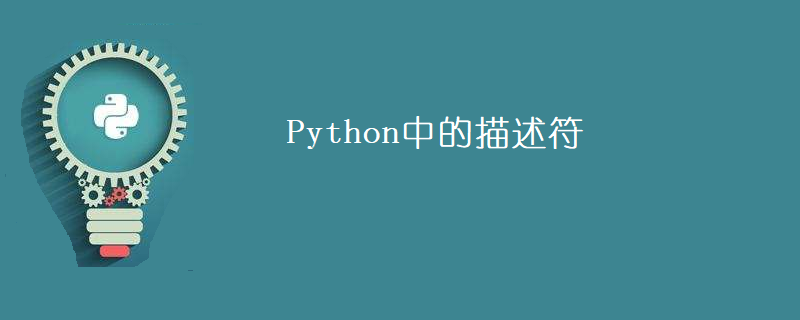描述符是一种在多个属性上重用相同访问逻辑的方法,它可以“劫持”原本会在 self.__dict__ 上执行的操作。描述符通常是一个类,其中至少包含__get__、__set__和__delete__三种方法中的一种,给人的印象是“将一个类的操作委托给另一个类”。静态方法、类方法和属性都是构建描述符的类。
我们先看一个简单的描述符的例子:
class MyDescriptor(object):
_value = ''
def __get__(self, instance, klass):
return self._value
def __set__(self, instance, value):
self._value = value.swapcase()
class Swap(object):
swap = MyDescriptor()注意MyDescriptor要用新式类。调用一下:
In [1]: from descriptor_example import Swap
In [2]: instance = Swap()
In [3]: instance.swap # 没有报AttributeError错误,因为对swap的属性访问被描述符类重载了
Out[3]: ''
In [4]: instance.swap = 'make it swap' # 使用__set__重新设置_value
In [5]: instance.swap
Out[5]: 'MAKE IT SWAP'
In [6]: instance.__dict__ # 没有用到__dict__:被劫持了
Out[6]: {}这就是描述符的力量。如果不了解大家熟知的staticmethod和classmethod,那么看Python实现的效果可能会更清楚:
>>> class myStaticMethod(object):
... def __init__(self, method):
... self.staticmethod = method
... def __get__(self, object, type=None):
... return self.staticmethod
...
>>> class myClassMethod(object):
... def __init__(self, method):
... self.classmethod = method
... def __get__(self, object, klass=None):
... if klass is None:
... klass = type(object)
... def newfunc(*args):
... return self.classmethod(klass, *args)
... return newfunc描述符在实际生产项目中有什么用?先看一下MongoEngine中Field的用法:
from mongoengine import *
class Metadata(EmbeddedDocument):
tags = ListField(StringField())
revisions = ListField(IntField())
class WikiPage(Document):
title = StringField(required=True)
text = StringField()
metadata = EmbeddedDocumentField(Metadata)有很多字段类型。事实上,它们的基类是一个描述符。我会简化它。我们来看看实现原理:
class BaseField(object):
name = None
def __init__(self, **kwargs):
self.__dict__.update(kwargs)
...
def __get__(self, instance, owner):
return instance._data.get(self.name)
def __set__(self, instance, value):
...
instance._data[self.name] = value许多项目的源代码看起来很复杂。剥离之后,原理其实很简单,复杂的是业务逻辑。
接着我们再看Flask的依赖Werkzeug中的cached_property:
class _Missing(object):
def __repr__(self):
return 'no value'
def __reduce__(self):
return '_missing'
_missing = _Missing()
class cached_property(property):
def __init__(self, func, name=None, doc=None):
self.__name__ = name or func.__name__
self.__module__ = func.__module__
self.__doc__ = doc or func.__doc__
self.func = func
def __set__(self, obj, value):
obj.__dict__[self.__name__] = value
def __get__(self, obj, type=None):
if obj is None:
return self
value = obj.__dict__.get(self.__name__, _missing)
if value is _missing:
value = self.func(obj)
obj.__dict__[self.__name__] = value
return value其实看类名就知道这是一个缓存属性。看不懂也没关系,用它:
class Foo(object):
@cached_property
def foo(self):
print 'Call me!'
return 42调用下:
In [1]: from cached_property import Foo
...: foo = Foo()
...:
In [2]: foo.bar
Call me!
Out[2]: 42
In [3]: foo.bar
Out[3]: 42可以看出,从第二次调用bar方法开始,实际使用的是缓存的结果,并没有实际执行。
说了这么多描述符的用法。我们为字段验证编写一个描述符:
class Quantity(object):
def __init__(self, name):
self.name = name
def __set__(self, instance, value):
if value > 0:
instance.__dict__[self.name] = value
else:
raise ValueError('value must be > 0')
class Rectangle(object):
height = Quantity('height')
width = Quantity('width')
def __init__(self, height, width):
self.height = height
self.width = width
@property
def area(self):
return self.height * self.width我们试一试:
In [1]: from rectangle import Rectangle
In [2]: r = Rectangle(10, 20)
In [3]: r.area
Out[3]: 200
In [4]: r = Rectangle(-1, 20)
---------------------------------------------------------------------------
ValueError Traceback (most recent call last)
<ipython-input-5-5a7fc56e8a> in <module>()
----> 1 r = Rectangle(-1, 20)
/Users/dongweiming/mp/2017-03-23/rectangle.py in __init__(self, height, width)
15
16 def __init__(self, height, width):
---> 17 self.height = height
18 self.width = width
19
/Users/dongweiming/mp/2017-03-23/rectangle.py in __set__(self, instance, value)
7 instance.__dict__[self.name] = value
8 else:
----> 9 raise ValueError('value must be > 0')
10
11
ValueError: value must be > 0如你所见,我们已经验证了描述符类中传递的值。 ORM就是这样玩的!
但是上面的实现有个缺点,就是自动化程度不是很高。你看height = Quantity('height'),它要求属性和Quantity的名字都叫height,所以可以不指定名字吗?当然可以,但是实现要复杂得多:
class Quantity(object):
__counter = 0
def __init__(self):
cls = self.__class__
prefix = cls.__name__
index = cls.__counter
self.name = '_{}#{}'.format(prefix, index)
cls.__counter += 1
def __get__(self, instance, owner):
if instance is None:
return self
return getattr(instance, self.name)
...
class Rectangle(object):
height = Quantity()
width = Quantity()
...Quantity的名字相当于类名+定时器。这个定时器每次调用都会叠加1,所以可以通过this来区分。值得一提的是,在 __get__ 中:
if instance is None:
return self在很多地方都可以看到,比如前面提到的MongoEngine中的BaseField。这是因为直接调用Rectangle.height等属性会报AttributeError,因为descriptor是实例上的一个属性。
PS:这个灵感来自《Fluent Python》,书中还有一个例子我觉得设计的很好。当需要验证的内容种类很多时,如何更好地扩展是一个问题。现在假设我们除了验证传入的值是否大于0之外,还要验证不能为空,必须是数字(当然三个验证一个方法是可以的,我这里是为了演示) ,我们先写一个 abc 的基类:
class Validated(abc.ABC):
__counter = 0
def __init__(self):
cls = self.__class__
prefix = cls.__name__
index = cls.__counter
self.name = '_{}#{}'.format(prefix, index)
cls.__counter += 1
def __get__(self, instance, owner):
if instance is None:
return self
else:
return getattr(instance, self.name)
def __set__(self, instance, value):
value = self.validate(instance, value)
setattr(instance, self.name, value)
@abc.abstractmethod
def validate(self, instance, value):
"""return validated value or raise ValueError"""现在添加一个新的检查类型,添加一个继承 Validated 并包含检查的 validate 方法的类:
class Quantity(Validated):
def validate(self, instance, value):
if value <= 0:
raise ValueError('value must be > 0')
return value
class NonBlank(Validated):
def validate(self, instance, value):
value = value.strip()
if len(value) == 0:
raise ValueError('value cannot be empty or blank')
return value上面显示的描述符都是类,那么可以用函数来实现吗?这也很好:
def quantity():
try:
quantity.counter += 1
except AttributeError:
quantity.counter = 0
storage_name = '_{}:{}'.format('quantity', quantity.counter)
def qty_getter(instance):
return getattr(instance, storage_name)
def qty_setter(instance, value):
if value > 0:
setattr(instance, storage_name, value)
else:
raise ValueError('value must be > 0')
return property(qty_getter, qty_setter)本文为原创文章,版权归知行编程网所有,欢迎分享本文,转载请保留出处!




内容反馈